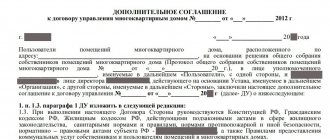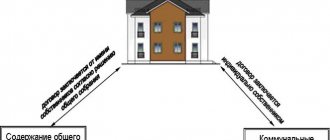Real estate owners have the right to obtain ownership of a land plot under high-rise and low-rise buildings. Privatization of land under an apartment building will help citizens jointly manage the territory located under the building.
What is an apartment building is a building with non-residential premises and a certain number of apartments and floors, intended for living. The classification of buildings depends on the type of house, length and number of floors. Long houses consist of several entrances, point houses have one.
According to the Housing Code, the land under an apartment building is common property. Residents can dispose of it, since it is considered common shared property.
The Land and Town Planning Codes establish the boundaries of the site. Rosreestr registers title documents for land and provides information about rights holders.
Federal Law No. 189 of December 9, 2004 enacts the Housing Code of the Russian Federation and regulates the privatization process. If the land under a residential building is not the property of the owners, then privatization is carried out. To do this, an application is submitted to state or municipal authorities and ownership is registered.
Who can apply
To carry out the privatization procedure, a general meeting of apartment owners is held and a representative is elected. On behalf of all owners, he submits an application to the authorized body for privatization. The process of transferring ownership of a plot of land under an apartment building can be initiated by one of the residents. This is established by law on the basis of a resolution of the plenum of the Supreme Court of the Russian Federation: The Constitution provides for the right of every person to protect his rights and interests, if they do not contradict the legislation of the Russian Federation. If one owner is denied privatization, this is contrary to regulations and is a violation.
House area size
The boundaries of the site for which proprietary rights can be registered are determined based on the following indicators:
- Development intensity (how close other buildings are).
- Number of floors of the apartment building and the number of people living.
- Proximity to roads and public places.
The area of the adjacent part can be equal to the area of the apartment building itself. This procedure is general, however, if there are many other structures nearby or a public place is located nearby, then the area may be reduced.
What rights do owners receive by privatizing a plot for an apartment building?
Having received ownership of the land, the rights holders can sell or lease it to local administrative authorities for the construction of a shopping and entertainment center, the construction of an office building and other needs.
When privatizing the local area, homeowners in an apartment building receive not only the rights to use the property, but also responsibilities. The right of ownership imposes obligations on the owners to pay land taxes, therefore, utility bills increase. Having received registration of ownership of the plot in the Unified State Register of Real Estate, residents can dispose of the land at their own discretion, for example, improve it: build a children's playground or sports ground. Ownership of a plot gives the right to receive income from its use.
Basic Concepts
The main concepts that are important in the case of privatization of such a territory are an apartment building (MKD) and the adjacent territory. In this case, you need to clearly understand the essence of each of them in order to avoid problems in implementing the procedure.
Apartment house
The essence of this definition lies in its name. In this case, it is a building with separate apartments. We are talking about separate premises, equipped with separate entrances and belonging to different owners. That is, each apartment is an independent room. This structure is different from a private home. The latter can also have several rooms and even floors. But it is integral housing, since it is built, as a rule, for one family, as opposed to an apartment building.
Local area
The adjacent territory differs from land plots for other purposes. In this case we are talking about boundaries.
The adjacent territory is considered to be the area adjacent to the building, or simply courtyard land.
This includes children's playgrounds and sports grounds, as well as parking for vehicles that were provided for in the house construction plan. At the same time, not the entire adjacent territory can be privatized. Driveways, squares, technical communications, cable networks and other public places are not transferred to the ownership of people.
Positive and negative points
Owners of the local area adjacent to the building must understand that privatization of the site implies certain responsibilities and obligations. As a rule, residents do not have a common opinion in their desire to establish and register ownership.
Let's look at the main advantages and disadvantages of the process.
Positive sides:
- privatization is carried out without material costs on the basis of legislation;
- Only the owners have the right to dispose of the territory under the MKD;
- making a profit from renting land;
- profitability of real estate.
Minuses:
- expenses for paying land tax;
- material costs for maintaining the site: repairs, landscaping;
- restrictions on land use: construction of garage cooperatives for WWII participants, disabled people, construction of recreation areas for children and sports facilities.
Material costs for taxation and maintenance of the site are distributed among the owners. Thus, residents decide to establish boundaries and rights to the site collectively, discussing the pros and cons of the procedure at a general meeting.
How can you use the privatized territory near your home?
The law strictly defines the types of use of land related to apartment buildings:
- landscaping of the territory (construction of playgrounds, installation of sports equipment, arrangement of recreation areas, landscaping of the yard, etc.);
- provision of individual plots for rent (for advertising structures, construction of commercial real estate, etc.);
- construction of garages for WWII veterans and disabled people;
- organization of parking spaces for residents of the house and their guests.
However, it is worth remembering that all buildings and objects being erected must not contradict legal norms. The norms of distances between buildings must be observed, and the rights of third parties must not be infringed. For example, if there is a passage through your yard to a public transport stop (the only one), and you fenced yourself off and made entry to the territory with passes, then in court you will be obliged to provide passage to residents of neighboring houses.
Example. Residents of one of the apartment buildings in Saratov privatized the adjacent territory. The right to manage the land plot was transferred to the chairman of the HOA. In order to raise additional funds for the maintenance of the house, he arranged paid parking for residents of neighboring houses. However, he did not coordinate with the responsible authorities; he accepted parking fees as voluntary sponsorship. A criminal case was opened against the chairman, and the prosecutor's office ordered the abolition of paid parking.
Privatization algorithm and authorities for appeal
In large settlements and cities - to the authorized bodies for property and land issues, divisions of departments. In the village - to the village administration. When applying, you must provide the necessary documentation and application.
Let's look at how to properly privatize land under an apartment building.
Step-by-step instructions:
- organizing a general meeting of residents to consider this procedure;
- an application is sent to the head of the authorized body based on the collective decision;
- a technical and cadastral plan of the land is prepared;
- appeal to the land issues committee after receiving permission from the administrative authority;
- documents received from the land committee are provided to the city or village administration;
- the municipal institution analyzes the provided documentation and makes a decision on the possibility of privatization;
- the boundaries of the land are determined and noted in the technical documentation;
- the administrative commission signs an act authorizing the registration of ownership of the property;
- An application for obtaining title documents is submitted to the registration chamber.
Nuances
The legislation stipulates that the owner of real estate located on territory owned by the state or municipality has the opportunity to buy or lease the land plot where this object is located.
It is established that a person has the opportunity to privatize only one plot of land free of charge during his life. Other procedures of this kind are carried out for a fee.
The procedure in question can be refused only when the site is seized or limited in circulation. The refusal is also provided for in a situation where the construction of another facility is planned on this territory. The decision to refuse can be appealed by the applicant by filing a claim with a judicial authority.
The final decision regarding privatization must be announced to the applicant no later than two weeks from the date of submission of the request to the relevant authority. At the same time, it should be noted that such a body has the authority to respond to a request within 2 months.
List of documents and sample application
Citizens can find out what papers owners need for privatization by calling the local administration's advisory line or personally visiting the institution.
Scroll:
- cadastral passport for land;
- topographic survey of the territory;
- area plan indicating boundaries;
- documents confirming the right of land use: land registration, administrative acts for the right of use and others;
- a certificate with assessment data is provided by the authorized body on land issues;
- issuance of papers with information on the area and volume of taxation - falls within the competence of the tax inspectorate;
- the technical examination bureau provides a certificate of the market value of the object;
- passport, TIN of the applicant;
- cadastral documentation for MKD;
- Extract from the Unified State Register of Registered Land Rights.
The land cadastral passport is the main document. In its absence, the owners will have to incur costs for processing additional papers. The law provides for the drawing up of a site plan with the entry of cadastral data on the basis of title documents. The application is drawn up according to the established template. The necessary documentation is attached to it. The local government body registers the application. The sample can be viewed on the Internet on the website of the administration or MFC.
Land tax
The owners pay the tax for privatized land once a year . The tax amount is calculated on the basis of Art. 388 of the Tax Code of the Russian Federation and other regulations. The basis for calculation is the cadastral value of the land, established based on the results of the latest assessment. The value of land today is determined by market prices.
At the same time, residents of the house will receive tax notices, which can be paid at all banks. If privatization was carried out not by residents, but by a legal entity, then it will be the legal entity that will pay the tax. For preferential categories of citizens (pensioners), the calculation is carried out at a reduced cadastral value, so for them the tax amount will be reduced.
Material costs during registration
The privatization process is carried out free of charge.
Paperwork involves material costs:
- upon receipt of cadastral documentation, material costs will be approximately 10,000 rubles;
- the cost of technical documentation varies depending on regional BTI prices;
- registration of rights in the Unified State Register of Real Estate – 500 rubles;
- legal entity – 2,000.
It is worth noting that the cost of services must be clarified in regional divisions.
Deadlines
Local authorities make a decision on the possibility of privatization no later than one month from the date of registration of the application. Cadastral and technical passports are produced within 14 days. Technical documentation is necessary to determine the share of territory for each resident. The registration process in the USRN takes two weeks. Submitting an application to establish rights through the MFC takes about 0 days.
Deadlines for reviewing and processing documentation:
- application from the owners for privatization of the site - 30 days;
- cadastral passport – 14 days;
- technical passport – 14 days;
- registration of ownership in the Unified State Register of Real Estate through Rosreestr – 14 days;
- registration of property rights through the MFC – 17–20 days.
Required papers
Administration employees require applicants to provide the following documents:
- application for privatization;
- power of attorney certified by a notary;
- a copy of the minutes of the owners' meeting;
- registration sheet for those present;
- decision on determining shares;
- duty payment receipt;
- information about the owners and the building itself (USRN extracts);
- title papers for the site;
- technical certificate of the building.
An application for privatization usually has a prescribed form; specialists will give the applicant a sample to fill out. In standard form, the application contains the following data:
- Name of the authority accepting the application.
- Details of the contacting representative or owners.
- Details of the power of attorney.
- Property location (full exact address).
- Request for possession of the yard.
- Place and time of compilation.
After concluding an agreement with the municipal authorities, the trusted person needs to contact Rosreestr. This body will register the property rights of the local area.
Rosreestr will require:
- a request (application) to formalize the transfer of ownership rights;
- power of attorney for the trustee;
- privatization agreement;
- technical plan of the yard;
- receipt for payment of duty.
Documentation is completed and information is entered into the Rosreestr database within five days (7 days a week).
Difficulties in generating documentation
At the general meeting, not all residents can come to a consensus on the need to privatize, since there is a responsibility for the maintenance of the common privatized property and material costs for registration and taxes.
The land for the building was provided illegally. This is usually determined by document analysis by authorized institutions.
In the absence of cadastral or technical documentation, the time frame for preparing a package of papers is extended. Employees of the BTI and cadastral service are called to the site to register new ones.
If the owner's representative has not provided documents certifying his authority, the process is impossible. When controversial situations arise, owners turn to the courts.
Controversial issues
Often problems with registration arise due to incorrect measurements of the area under a multi-story building. Therefore, when carrying out this procedure, it is desirable that the majority of residents be present. It is important to do everything correctly and without mistakes the first time. The second privatization will already be paid. Do not forget about qualified assistance from specialists.
Dear visitors to our site, we hope that we were able to fully cover the topic that interests you. Anyone who liked the material can share this information on the forum or on social networks. We will be glad to receive your comments, opinions, examples from personal experience. If you have any questions, please contact our lawyer at the specified phone number.
Important points
Land transferred to private ownership must be used by all residents. There is no share allocated per person. Completion of a transaction for the sale of an apartment involves the transfer of land rights to the new owner. The land owned by the owners cannot be sold separately from the building.
The Constitution of the Russian Federation presupposes the right of residents to own and dispose of the territory. Registration of title to a residential property determines the right to the land under the house. An apartment building on a privatized site may be designated for demolition based on a decision of local authorities. When living in a cooperative building, the area under the house is leased; after the expiration of the contract, it is possible to register the plot as property.
By ordering an extract from the Unified State Register of Real Estate, you can get an answer to the question: who can own the land under the house?
Who can be the initiator
The initiators can be:
- The development company, if we are talking about a new high- or low-rise building.
- Owners of premises, through a single legal representative.
- Each one lives separately.
- Representatives of management companies.
- Entrepreneurs and legal entities.
It should be noted that the territory adjacent to the house is privatized only if there are rights to the apartment. Otherwise, the applicant will not be able to take part in the procedure.








